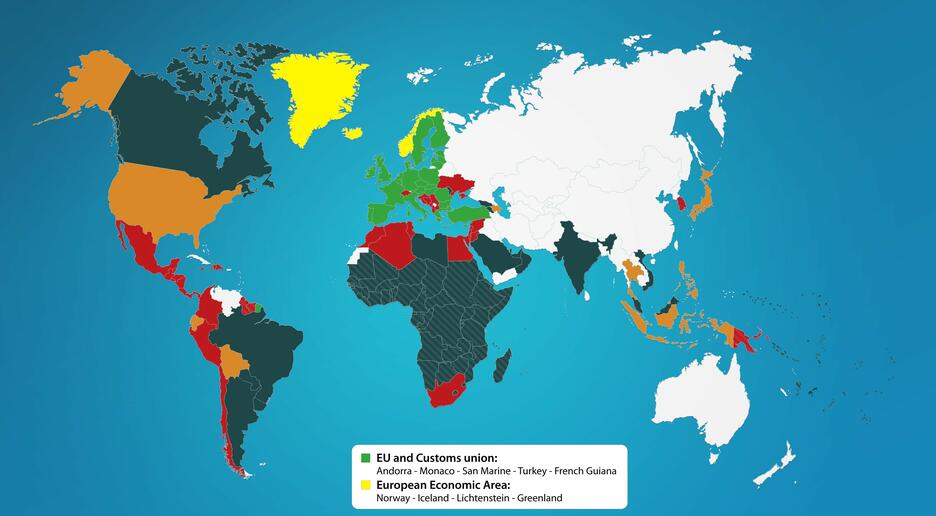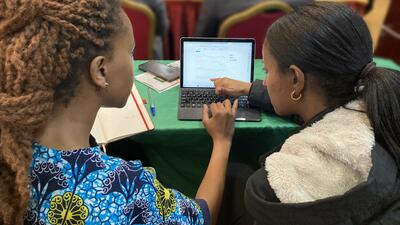Export helpdesk: An online guide to accessing European markets
With a share of around 20% of global imports and exports, the EU is the world's largest single market. It needs the products it imports, be they mineral oil products; intermediate products for various industrial sectors such as electronic equipment, motor vehicles and chemicals; or agricultural products such as fruits, vegetables and other foods. It is also committed to helping developing countries tie their economies more firmly to global trade flows. In practical terms, it does this through preferential trade arrangements. Although it is possible for exporters in developing countries to export to the EU without quota restrictions or duty payments, some specific technical requirements remain. The Export Helpdesk is a single access point for the information business needs to fully benefit from opportunities in the EU.
Click on the image to see the full map
Source: Export Helpdesk
No customs duties within the single market
The EU is a customs union and its 27 member countries form a single territory for customs purposes. This means: no customs duties are paid on goods moving between EU countries; all countries apply a common customs tariff for goods imported from outside the EU; and goods that have been legally imported can circulate throughout the EU with no further customs checks.
Exporting products to the EU
When exporting to the EU, companies access a single market of 27 countries with over 500 million consumers. The principle of free movement of goods, allowing goods to be transported and sold anywhere in the EU, is a cornerstone of the EU market. To a significant extent, complex and varied national laws have been replaced by a single set of European rules, cutting down on costs and inconvenience for businesses wanting to trade in other EU countries. The EU market for goods is already highly integrated and harmonized among the 27 countries. However, to make the EU market work efficiently, businesses have to respect a number of rules and compete fairly. Anti-competitive behaviour, such as abuse of a dominant market position, price-fixing agreements and distorting public support, are prohibited. To take part in EU trade, it is necessary to know the procedures to follow. These cover:
• Classifying products and finding the correct product codes;
• Completing a customs declaration with the necessary documents, including a single administrative document, commercial invoice, freight documents, insurance papers and a packing list;
• Calculating applicable tariffs and quotas, for example, for agricultural products, value-added tax rates and excise duties in EU countries;
• Preparing a product so that it complies with product-specific requirements related to public, plant and animal health, safety, packaging and labelling, and marketing standards;
• Finding the relevant national authorities and border inspection posts.
Information on these processes is provided by the Export Helpdesk and is based on current EU law. Where there is no EU law applicable to a specific product, national law in the importing country will apply and the authorities of the destination country should be contacted.
Preferential trade agreements
Preferential trade agreements the EU has concluded with countries or regions, along with their specific sets of rules, are integral to the Export Helpdesk. These agreements include:
• Customs unions;
• The Generalised System of Preferences;
• The preferential duty regime for African, Caribbean and Pacific States;
• Free trade agreements;
• Autonomous trade preferences.
For imports under a preferential regime it is important to prove that the product de facto originates from a country that benefits from preferential arrangements. The Export Helpdesk explains which rules of origin apply and which proofs of origin are required to qualify for a preferential tariff. The Helpdesk also integrates antidumping law, providing information on additional duties that may be temporarily applied according to the findings and decisions of the EU Antidumping Committee.
Figures on trade flows
Before deciding to access foreign markets, the Export Helpdesk can be used to look at current trade flows. The statistics section of the website provides trade statistics between any country and the EU as a whole and between any country and individual EU countries. Figures are available from 2002 to 2011 and can be exported to Microsoft Excel spreadsheets.
Using the Export Helpdesk
A computer and Internet access are required to use the Export Helpdesk, and once an Internet connection is made all the necessary export data is available and can be searched. The service is provided by the European Commission and has been set up specifically for developing countries. It is free of charge, available around the world and a large part of the information is available in six languages: English, French, Spanish, Portuguese, Arabic and Russian. Very specific information is available only in English. For further information on the Export Helpdesk visit http://exporthelp.europa.eu













